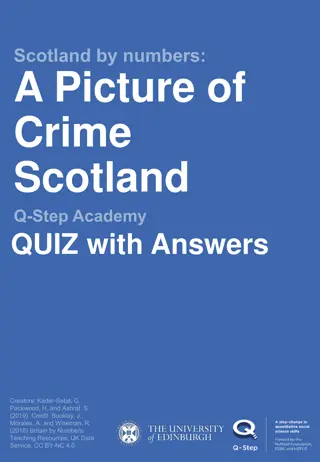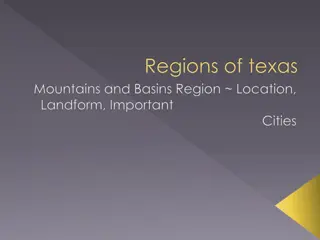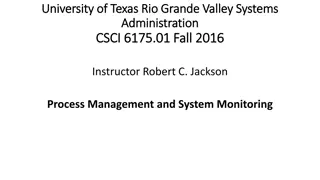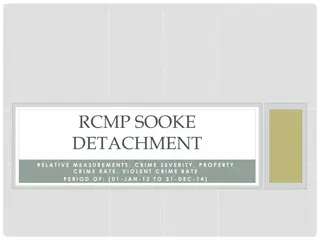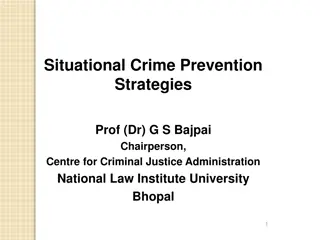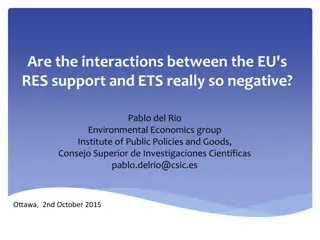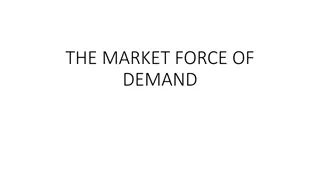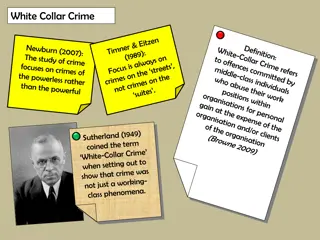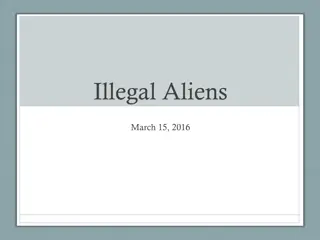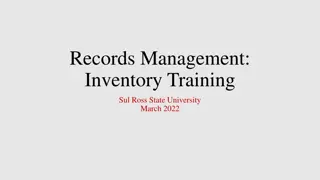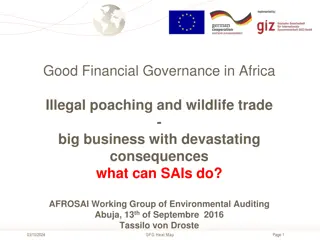Impact of Illegal Goods Demand on Crime Rate in Rio Grande do Sul
This study examines the correlation between the demand for illicit goods and the increase in larceny rates in Rio Grande do Sul between 2002 and 2015. Utilizing both Traditional Economics and Behavioral Economics frameworks, it aims to analyze the incentives influencing criminal behavior and consumer choices in the illegal market. By quantifying assaults and establishing econometric models, the research seeks to shed light on the determinants of crime in the state.
Download Presentation

Please find below an Image/Link to download the presentation.
The content on the website is provided AS IS for your information and personal use only. It may not be sold, licensed, or shared on other websites without obtaining consent from the author. Download presentation by click this link. If you encounter any issues during the download, it is possible that the publisher has removed the file from their server.
E N D
Presentation Transcript
RATIONALITY IN ILLEGAL RATIONALITY IN ILLEGAL MARKETS: MARKETS: The effect of illegal goods The effect of illegal goods demand on crime rate demand on crime rate MSc. Ingrid Rafaele Rodrigues Leiria Prof. PhD. Tiago Wickstrom Alves Prof. PhD. Alexsandro Marian Carvalho July, 2018
SUMMARY PROBLEM DEFINITION OBJECTIVE JUSTIFICATION ECONOMIC THEORY AND CRIMINALITY METHODOLOGY RESULTS ANALYSES FINAL CONSIDERATIONS July, 2018
PROBLEM DEFINITION Traditional Economics and Behavioral Economics: Seeks to understand the incentives that affect the decision maker in order to understand their actions; Discussion of the demand for illicit goods as an illegal market, which has as many incentives as the legal market; Increase in the last years of Larceny: Art. 155 (theft) and Art. 157 (robbery). Was the demand for illicit goods determinant for the increase of larceny in Rio Grande do Sul between 2002 and 2015?
SUMMARY PROBLEM DEFINITION OBJECTIVE JUSTIFICATION ECONOMIC THEORY AND CRIMINALITY METHODOLOGY RESULTS ANALYSES FINAL CONSIDERATIONS
OBJECTIVE GENERAL OBJECTIVE Analyze if the demand for illicit goods was determinant of the increase of the assault rate in the State between 2002 and 2015. SPECIFIC OBJECTIVES I) To quantify II) Establish and estimate an econometric model that presents the determinants of crime in the State. the assaults that occurred in the State;
SUMMARY PROBLEM DEFINITION OBJECTIVE JUSTIFICATION ECONOMIC THEORY AND CRIMINALITY METHODOLOGY RESULTS ANALYSES FINAL CONSIDERATIONS
JUSTIFICATION Few research showing the role of criminals and consumers in the distribution and marketing of stolen goods; Importance of a more detailed investigation to understand not only the supply of labor willing to commit the crime, but also the demand willingness to acquire these criminal services Seek to understand the incentives present in this market, using assumptions from the Behavioral Economics and Traditional Economic Theory.
SUMMARY PROBLEM DEFINITION OBJECTIVE JUSTIFICATION ECONOMIC THEORY AND CRIMINALITY METHODOLOGY RESULTS ANALYSES FINAL CONSIDERATIONS
ECONOMIC THEORY AND CRIMINALITY The criminal weighs the consequences of his action with the immediate benefit (monetary returns) of it. The main foundations for the construction of the Economic Theory of Crime are: i) search for the maximization of the agents' choices; ii) the legal rules are equivalent to the prices, and the agents respond to the incentives in this environment; iii) search for increased wealth and well-being.
ECONOMIC THEORY AND CRIMINALITY HYPOTHESES 1. Demand for illicit goods directly influences the state's crime rate as monetary returns from this market increase; 2. As demand for illicit goods increases, the supply of available criminal labor increases its market share.
SUMMARY PROBLEM DEFINITION OBJECTIVE JUSTIFICATION ECONOMIC THEORY AND CRIMINALITY METHODOLOGY RESULTS ANALYSES FINAL CONSIDERATIONS
METHODOLOGY QUANTITATIVE RESEARCH Stage: Construction of the SEM (Structural Equation Model) model; Collection of data and tests with available variables; Development of a model (in panel) for the rate of assaults as dependent.
METHODOLOGY MODEL OF STRUCTURAL EQUATIONS The model of equations developed is based on the Model of Multiple Causes and Multiple Indicators (MIMIC), elaborated by Joreskog & Goldberger (1975) . MIMIC belongs to a certain type of structural equation (SEM), applied largely to Underground Economy research, or to research in the field of sociology and psychology. Structural Equation Measurement Equation ? = ? ? + ? ? = ? ? + ?
METHODOLOGY Structural Equation: FIGURE 1 Path Model of DEMAND and SUPPLY ?1 = ?11?1 + ?12?2 + ?13?3+ ?14?4 + ?15?5 + 1 ?2 = ?21?4 + ?22?5 + ?23?2 + ?24?6 + ?25?7 + ?26?8+ ?27?9+ 2 Measurement Equation: Y1 = 11 1 + 61 2 + 3 Y2 = 22 1 + 72 2 + 4 Y3 = 33 1 + 83 2 + 5 Y4 = 44 1 + 94 2 + 6 Ingrid Leiria 2016/1 Y5 = 55 1 + 105 2 + 7 Source: Elaborated by the author.
METHODOLOGY Latent variables (unknown): Supply and demand; Indicator variables: Measurement variables for unknown phenomena (latent); Observed variables (causal): Those that directly impact unknown variables. Ingrid Leiria 2016/1
METHODOLOGY APPLICATION OF PANEL DATA After establishing the supply and demand relationships, with their respective variables, a panel data estimate was estimated by GMM - Generalized Moments Method with generalized IV estimators as defined by Arellano-Bond (1991); Following the specification of Arellano-Bond for panel with dynamic instruments with lags that vary by observation and using the White Period matrix as covariance method. Ingrid Leiria 2016/1
SUMMARY PROBLEM DEFINITION OBJECTIVE JUSTIFICATION ECONOMIC THEORY AND CRIMINALITY METHODOLOGY RESULTS ANALYSES FINAL CONSIDERATIONS
RESULTS ANALYSES Figure 2 Path Model of Demand and Supply STRUCTURAL EQUATION: Demand = 0.392*(r_unemp) + 0.712*(r_bolsa) + 0.0383*(r_drugpos) + 0.108*(l_prim) + (-0.025)*(gdp_cap) + 0.0019 Supply = (-0.04)*(income) + 0.192*(r_mort) + (- 0.157)*(r_bolsa) + 0.020*(r_weap) + (-0.0154)*(r_cappri) + (- 0.872)*(r_police) + 0.074*(r_traf) + 0.0837 DETERMINATION COEFICIENT SRMR 0.039 ; CD 0.936 Ingrid Leiria 2016/1 Source: Elaborated by the author. Model construction using software STATA.
RESULTS ANALYSES Graph 1: Supply Rate X Larceny Rate between 2002 and 2015 From 2002 to 2006 the supply rate represented -0.89, from 2006 to 2011, -0.79 and from 2011 to 2015, -0.73; These values may be indicative of the labor supplied or earned new workers or that the criminals are working for longer. Source: Elaborated by the author. Note 1: Larceny: Group considering robbery rate, vehicle robbery rate, theft, vehicle theft rate, and robbery followed by death. Ingrid Leiria 2016/1
RESULTS ANALYSES Graph 2: Demand Rate X Larceny Rate between 2002 and 2015 In 2002 the demand for illicit goods represented a rate of 0.47 already in 2013, this rate reached 0.18, rising again in 2015 with 0.20; Even with this reduction in the growth of demand rates, it has a positive impact on the increase of criminal indicators, as there are more illegal transactions in this market when there is a higher incidence Source: Elaborated by the author. Note 1: Larceny: Group considering robbery rate, vehicle robbery rate, theft, vehicle theft rate, and robbery followed by death. Ingrid Leiria 2016/1 in the larceny rate.
RESULTS ANALYSES Graph 3: Unemployment Rate X Demand Rate between 2002 and 2015 The demand represents a development very close to the unemployment rate. A considerable part of the demand rate is explained by the unemployment rate, abandonment in primary education, the rate of families receiving income through the income distribution program Bolsa Fam lia , drug consumption rate, and GDP per capita. Ingrid Leiria 2016/1 Source: Elaborated by the author.
RESULTS ANALYSES Graph 4: Reduction in 1% in the demand and supply rate Graph 5: Reduction in 10% on demand and supply Source: Elaborated by the author. Note1: These reductions are based on the total rate of each assault rate. Note 2: If the theft rate is 100, with the reduction of demand for illicit goods by 1%, the value of 100 becomes 95.2. And with the 1% reduction in supply, the theft rate becomes 97.1 Source: Elaborated by the author. Note1: These reductions are based on the total rate of each assault rate. Note2: If the theft rate is 100, with the reduction of the demand for illicit goods by 10%, the value of 100 becomes 69. And with the 10% reduction in supply, the theft rate becomes 77. Ingrid Leiria 2016/1
RESULTS ANALYSES Table 2: Estimated parameter* for the demand Dependent Variable: R_LARCENY Transformation order to normalize some variables as a function of the magnitude differences of the same ones in the sample. GDP and Population (POPULA) using logarithm in Standard Deviation Variables Coeficient t-statistic Prob. R_BOLSA R_UNEMP LOG(GDP) LOG(POPULA) R_DRUGPOS(-1)*L_PRIM(-1) R_MORT(-1)*TX_TRAF(-1) -0.234446 12.50254 -53.04976 664.6127 0.341758 -0.180157 0.013310 0.816884 1.075.019 9.201.926 0.066976 0.067730 -17.61389 15.30517 -4.934776 7.222539 5.102682 -2.659950 0.0000 0.0000 0.0000 0.0000 0.0000 0.0083 Interaction delay them in a period. between variables and Specification Cross-section fixed (first differences) (R_DRUGPOS(-1)*L_PRIM(-1)) (R_MORT(-1)*TX_TRAF(-1)) Mean dependent var S.E. of regression J-statistic -8.553.264 29.32900 24.18996 S.D. dependent var Sum squared resid Instrument rank 29.67944 249455.2 29 * Note: Dynamic panel by GMM, fixed effects, Arellano and Bond estimators (1991) and consistent White matrix for periods. N = 296 observations, with 28 cut-off observations and the period from 2003 to 2013. Source: Elaborated by the author. Ingrid Leiria 2016/1
RESULTS ANALYSES Table 3: Estimated Models Analyzing the demand, as there is an economic crisis affecting the growth rates of the country or state, crime rates tend to increase, since the individual who acquired original goods when employed, no longer have that income; SEM GMM Demand Supply Larceny Rate VARIABLES r_unemp r_bolsa r_cappri r_weap r_morta r_police r_traf gdp_cap l_prim r_drugpos income log(gdp) log(popula) r_drugpos(-1)*l_prim(-1) r_mort(-1)*r_traf(-1) Coeficient p-value .3924958 .0712697 Coeficient p-value Coeficient p-value 12.50254 -0.234446 0.000 0.000 0.0000 0.0000 0.000 0.000 0.010 0.000 0.000 0.000 -.1570125 -.0154511 .0200101 .1920939 -.8726557 .0740813 0.000 -.025 .1083445 0.002 .0383697 0.003 0.000 -.04 Or, diminished cheaper considering the origin of these goods. the income leading goods, may to have for without 0.0000 0.0000 0.0000 0.0083 -53.04976 664.6127 0.341758 -0.180157 look 0.000 0.000 0.000 0.000 0.008 0.000 0.000 0.000 0.000 0.000 r_rob r_robvei r_thef r_thefvei r_robde 1 .6664222 .8648085 .7818333 .2816864 .1342512 1 .221441 .4688063 .0855509 Ingrid Leiria 2016/1 Source: Elaborated by the Author. Note1: STATA 14 was used to estimate SEM. EVIEWS 8 was used to estimate GMM. .
SUMMARY PROBLEM DEFINITION OBJECTIVE JUSTIFICATION ECONOMIC THEORY AND CRIMINALITY METHODOLOGY RESULTS ANALYSES FINAL CONSIDERATIONS
FINAL CONSIDERATIONS The demand rates are affected to a great extent by the economic condition that the individual is inserted, in moments of economic crisis, in situations of loss, the decision making agent will seek to avoid losses; Just as demand has increased its share in the criminal market, supply rates have also been increasing, especially in 2015, which was when it hit its lowest negative rate. Incentives in the criminal market may be considered to be greater than those belonging to the formal market, leading to a migration of workers or more hours available to commit crimes. Ingrid Leiria 2016/1
FINAL CONSIDERATIONS 1) The hypothesis of the participation of criminal labor force in the market increasing as there are more incentives proved to be valid. As legal market wages decrease, there is an increase in the supply of labor available for criminal activities. The supply of labor, search for sufficient incentives, these being in the majority monetary to justify the accomplishment of the illegal act. Ingrid Leiria 2016/1
FINAL CONSIDERATIONS SUGGESTIONS: i) greater awareness by the media/state as to the consequences of acquisition of illegal products; ii) review of the crime of receiving (Law No. 9.426, of 1996); iii) actions jointly between public security departments mainly in operations aimed at inhibiting the supply of illicit goods, going to places where these goods are marketed. Ingrid Leiria 2016/1
FINAL CONSIDERATIONS 2) Second hypothesis: As the demand for illicit goods increases, the criminal labor force available in the market increases its market share In the analyzed period, the supply rate presented decreasing negative growth rates; Incentives in the criminal market may be considered to be greater than those belonging to the formal market, leading to a migration of workers or more hours worked for the returns of crimes. Ingrid Leiria 2016/1
FINAL CONSIDERATIONS FUTURE WORKS To compare the results obtained in this region, with other states, in order to verify if there is difference for different samples; The direct questioning with the criminals as Sutton (2008) carried out, so it would be sought to understand directly with the offending agent the main factors that influenced them to commit illicit acts. Ingrid Leiria 2016/1
THANK YOU! Ingrid Leiria 2016/1
RATIONALITY IN ILLEGAL RATIONALITY IN ILLEGAL MARKETS: MARKETS: The effect of illegal goods The effect of illegal goods demand on crime rate demand on crime rate MSc. Ingrid Rafaele Rodrigues Leiria ingridleiria@gmail.com Prof. PhD. Tiago Wickstrom Alves tw@unisinos.br Prof. PhD. Alexsandro Marian Carvalho alexsandromc@unisinos.br July, 2018



